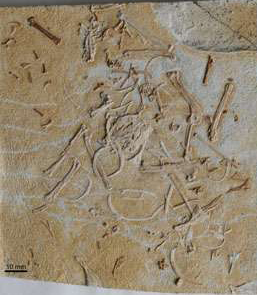The Evolution of the Light but Strong Skeleton for Powered Flight
It is widely accepted that birds evolved from dinosaurs. The Order Dinosauria is now classified into two parts, the non-avian dinosaurs, which are extinct and the avian dinosaurs (the birds), which are very much still with us. However, the evolution of the specialised anatomy that enables powered flight is not well understood.
Birds have several skeletal modifications that greatly assist them when it comes to their aerial abilities. Any aeronautical engineer will expound the virtues of a light but strong frame for an aircraft, birds have a light but strong skeleton with many elements fused for greater rigidity. A team of scientists writing in the “Proceedings of the National Academy of Sciences”, have provided new evidence to help explain how these remarkable anatomical modifications came about. This evolutionary story is likely to be much more complicated than previously thought.
Some Theropod Dinosaurs Evolved into Birds Skeletal Similarities and Differences

A skeleton of the theropod dinosaur compared with a simplified skeleton of a modern bird.
Picture credit: Everything Dinosaur
The picture above shows the skeleton of the recently described oviraptorid Corythoraptor jacobsi compared to that of a modern bird. The bird skeleton shows a number of adaptations for powered flight, such as fused hand and foot bones and an enlarged sternum but the ground-dwelling Oviraptor possesses number of anatomical characteristics which show its affinity to modern birds. Both Aves and the Oviraptoridae are included together in the clade Maniraptora which consists of modern birds and their closest extinct relatives from the coelurosaurian theropods.
Pterygornis dapingfangensis – Fused Bones
A second, beautifully-preserved specimen of the Early Cretaceous enantiornithine bird Pterygornis dapingfangensis has fully fused hands (carpometacarpus bones) as well as a fused pelvic girdle. Dating from around 120 million years ago, this specimen is the oldest known bird fossil which shows these modifications for powered flight. The fossil comes from the Jiufotang Formation of Liaoning Province (north-eastern China). This sparrow-sized creature is one of several genera known from these Lower Cretaceous deposits, only the Solnhofen deposits of Germany are older in terms of the bird fossils they contain.
The exquisite specimen shows that the carpometacarpus and the pelvis are completely fused, it had been thought that these traits did not appear in Aves until the Late Cretaceous. The fossil record had shown that all bird fossils associated with Upper Cretaceous deposits have a completely fused hand and pelvis. Thanks to this newly published scientific paper, the historical origin of these avian bone fusions has been pushed back some forty million years.
The Second Specimen of Pterygornis dapingfangensis

Pterygornis dapingfangensi fossil.
Picture credit: W. GAO (Chinese Academy of Sciences)
Great Fossils but Squashed Flat!
Named in 2015 from a single, disarticulated specimen, discovered near the town of Dapingfang, Chaoyang County in Liaoning Province, Pterygornis shows a number of unique autapomorphies that distinguishes it from other enantiornithines and the second fossil has shown that the body plan for a rigid, fused skeleton was present in at least one species of bird from the Early Cretaceous.
Dr Steve Brusatte (University of Edinburgh), who reviewed the scientific paper, commented:
“These [fused bones] are fundamental features of the modern bird blueprint, and are integral to giving birds the strength and rigidity needed to fly. There seems to have been a lot of experimentation among early birds, with different species trying out different ways of making their skeletons stronger and better able to withstand the rigours of flight.”
Sadly, many of the fossils from the Jiufotang Formation have been compressed and distorted as a result of the fossilisation process. However, despite the taphonomy that ends with a lot of the fossils from these rocks being squashed flat, the researchers from the Chinese Academy of Sciences were able to identify that the fused bones in the second known specimen of Pterygornis were not a result of pathology or the fossilisation process.
The Disarticulated Holotype Specimen of Pterygornis dapingfangensis

The scattered and disarticulated fossil remains of Pterygornis dapingfangensi.
Picture credit: Wang Min
The Search for Transitional Fossils (Birds Evolved from Dinosaurs)
The lack of transitional fossils has hindered the process of identifying the evolutionary process towards the modern bird skeleton. More fossils would help to demonstrate how birds evolved from dinosaurs. However, in this research paper the authors outline how the fusion of pelvic bones and those in the hands and feet may have evolved independently in non-avian dinosaurs, primitive and more advanced birds.
The scientists speculate that varying degrees of bone fusion were likely to have evolved in basal birds, perhaps as a result of environmental pressures or related to a refinement of flight capability. It seems that the developmental pathway from ground-dwelling dinosaur to the skeletal shape of living birds has a few more surprises to spring before it is more fully understood.
Visit the Everything Dinosaur website: Everything Dinosaur.





